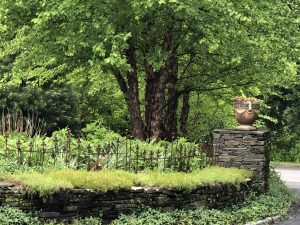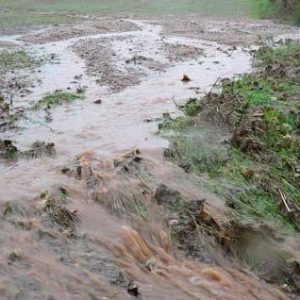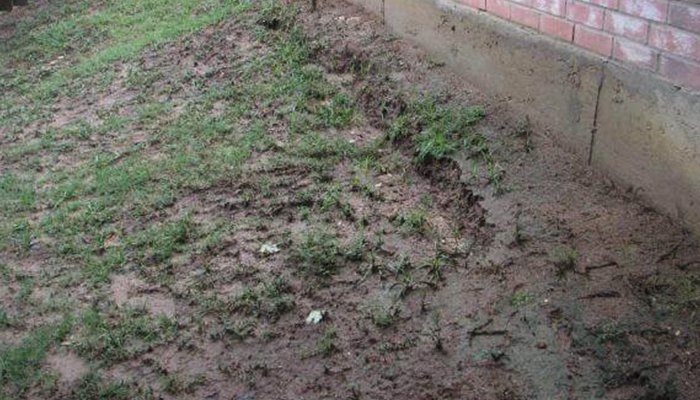Soil erosion is the displacement of the upper layer of soil and is a form of soil degradation.
Soil erosion is caused by activity of erosive agents like water, ice, snow, wind etc. The gradual erosion of soil can lead to pollution of drinking water, due to sedimentation, as well as a harmful increase of algae growth in water, and compromised structural integrity of buildings and roadways.
Soil erosion is commonly a big problem for homes that are built on a slope. Due to increased overall rainfall in our region, erosion has become an even bigger concern.
There are, however, some ways to prevent soil erosion on your property through landscaping techniques.
- Plant – Planting flowers or trees is one of the easiest ways to help with soil erosion, because these plants and trees act as a shield, lessening the impact of water runoff from rainfall. They also help to stabilize the dirt by anchoring through roots. These roots also soak up excess water, preventing soil softness.
 Mulch – Adding a layer of mulch and/or fertilizer can help to absorb some water. Mulch also creates a higher pH level in soil, which contributes to an overall healthier soil. If you are using fertilizers and pesticides, avoid doing so within 10 feet of streams, as this runoff could be carried downstream leading to pollution of bodies of water.
Mulch – Adding a layer of mulch and/or fertilizer can help to absorb some water. Mulch also creates a higher pH level in soil, which contributes to an overall healthier soil. If you are using fertilizers and pesticides, avoid doing so within 10 feet of streams, as this runoff could be carried downstream leading to pollution of bodies of water.- Retaining Walls – Hardscape features within your landscape are not only appealing visually, but they serve an important purpose. Incorporating retaining walls into your backyard landscape design is a great way to prevent soil erosion and runoff. A retaining wall is used for supporting soil mass laterally so the soil can be retained at different levels on two sides. Their designs allow for them to retain water and runoff at a slope that wouldn’t naturally occur.
- Extra Seed – Adding extra seed to cover your ground and fill in bare patches of your yard can help to increase root density, and thus work to combat erosion.
- Avoid Excessive Irrigation – Excessive irrigation and outdated tilling practices leads to a reduction in the amount of nutrients in soil. This makes the soil less fertile, causing difficulties with natural vegetation growth.
- Gutter Systems – Rain runoff from your roof can lead to erosion around the base of your home. The best way to combat this is a properly installed gutter system (that is maintained regularly to prevent clogs).
- Rain Garden – A rain garden is a small, planted depression that helps to minimize erosion by catching and slowing down water as it makes its way downhill. The best plants for your rain garden are those that can thrive in conditions with periods of wetness followed by dryness. A rain garden can also be a very aesthetically appealing addition to your yard.
 While erosion of soil is of particular concern in farm land, steep hillsides, or along a stream, erosion around a home can compromise foundations. Since soil erosion can often lead to pollution and compromised structural stability, continued water runoff and erosion on your property could potentially be damaging to your home and surrounding bodies of water. During periods of heavy rainfall, streams and rivers need to continue to flow smoothly otherwise flooding can occur. The sediment that is created by soil erosion traps excess water, pushing it back onto the land causing flooding.
While erosion of soil is of particular concern in farm land, steep hillsides, or along a stream, erosion around a home can compromise foundations. Since soil erosion can often lead to pollution and compromised structural stability, continued water runoff and erosion on your property could potentially be damaging to your home and surrounding bodies of water. During periods of heavy rainfall, streams and rivers need to continue to flow smoothly otherwise flooding can occur. The sediment that is created by soil erosion traps excess water, pushing it back onto the land causing flooding.
Soil erosion can not only be damaging to the environment, but also the structural integrity of your home. By integrating some of these rather easy additions into your landscape design projects, you can help to prevent erosion and excess water runoff. When planning your landscape design project with Red Cedar, we’ll be sure to consider the potential for water runoff and make suggestions to help avoid dangerous erosion! Contact us today for your free consultation!


